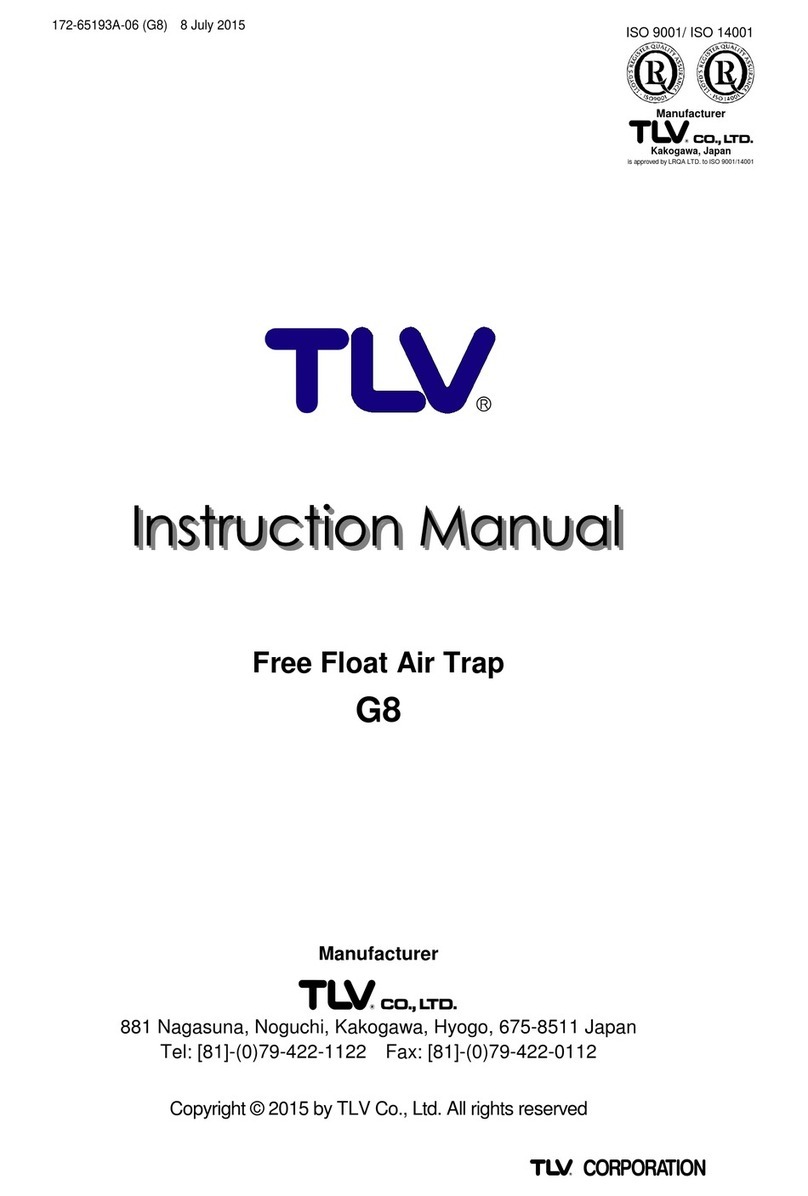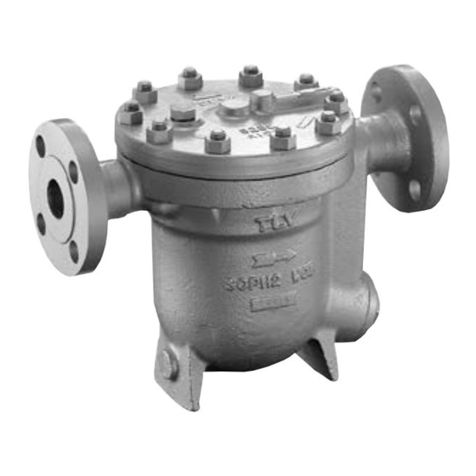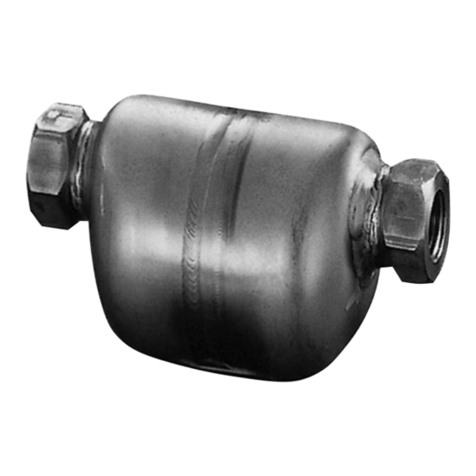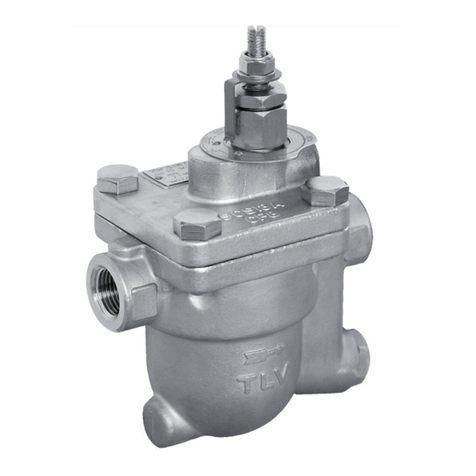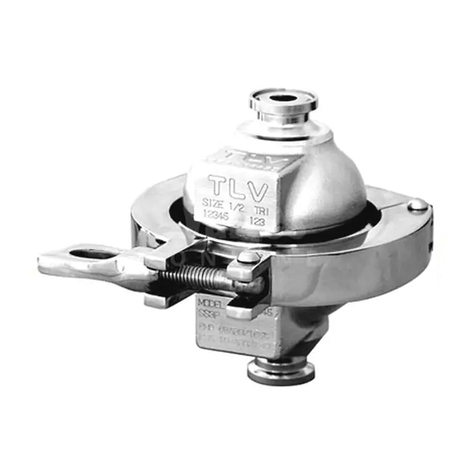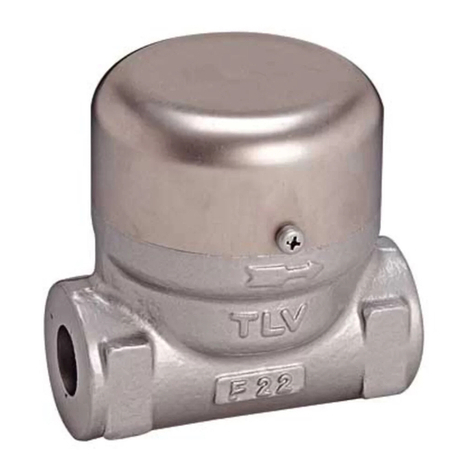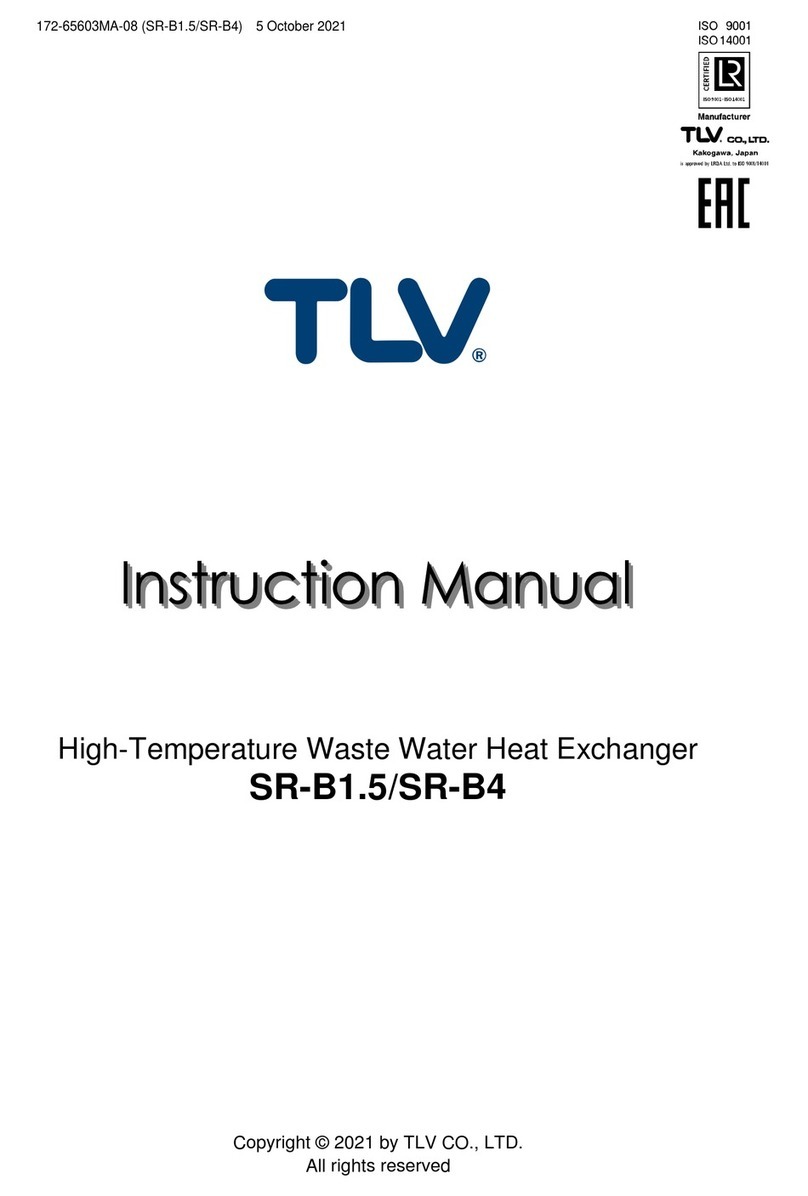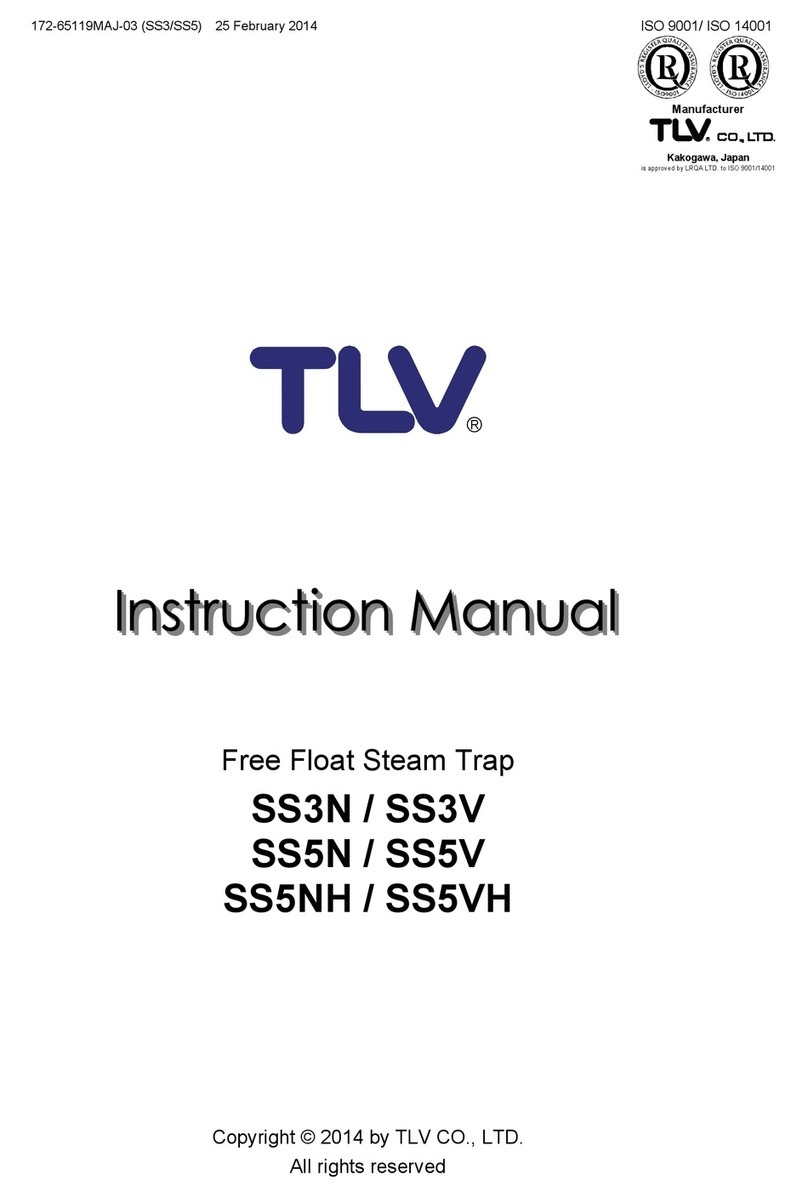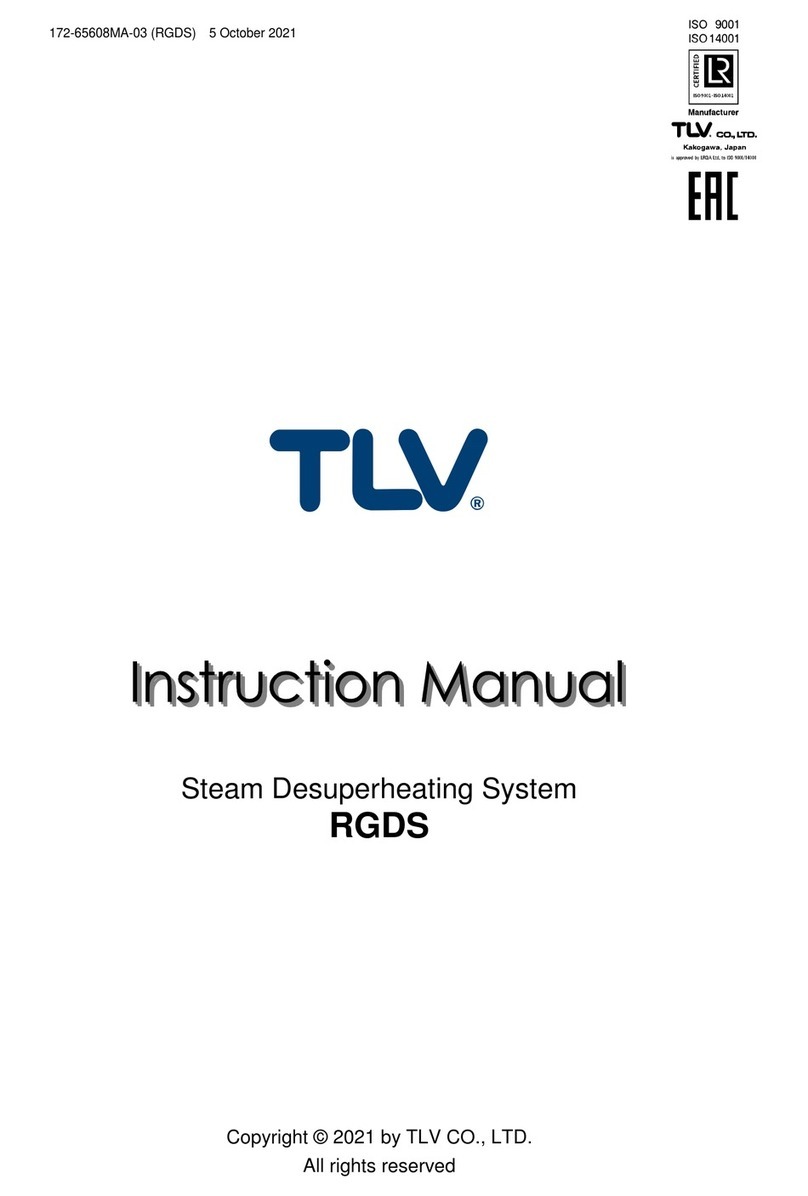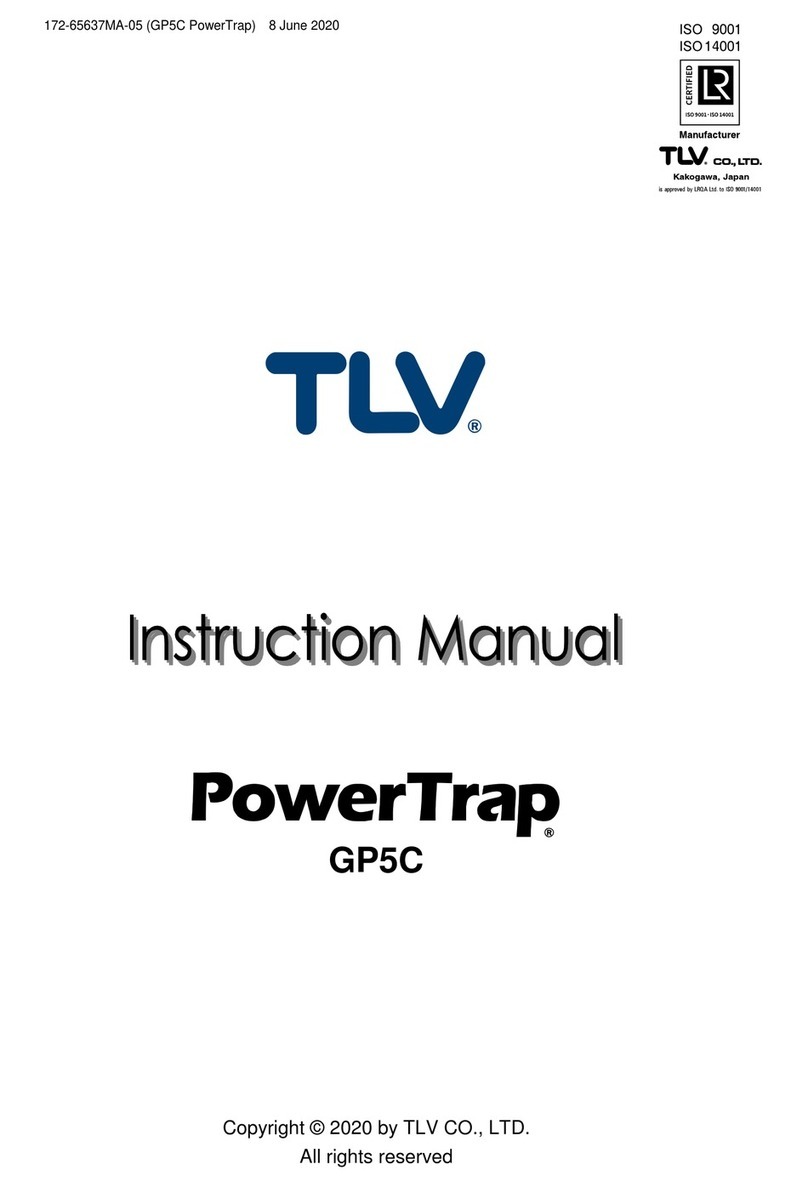TLV RT3A User manual

172-65191MA-03 (RT3A) 28 April 2009
Radiator Trap
RT3A
Copyright © 2009 by TLV CO., LTD.
All rights reserved
ISO 9001/ ISO 14001
Manufacturer
Kakogawa, Japan
is approved by LRQA LTD. to ISO 9001/14001

172-65191MA-03 (RT3A) 28 Apr 2009
1
Contents
Introduction........................................................................1
Safety Considerations........................................................2
Checking the Piping...........................................................4
Operation...........................................................................4
Specifications.....................................................................5
Configuration......................................................................5
Installation..........................................................................6
Maintenance ......................................................................7
Disassembly / Reassembly................................................8
Troubleshooting.................................................................9
Product Warranty.............................................................10
Introduction
Thank you for purchasing the Radiator Trap.
This product has been thoroughly inspected before being shipped from the factory.
When the product is delivered, before doing anything else, check the specifications
and external appearance to make sure nothing is out of the ordinary. Also be sure to
read this manual carefully before use and follow the instructions to be sure of using
the product properly.
The RT3A radiator trap is used in buildings such as schools, hotels, hospitals and
offices, to discharge only low temperature condensate generated in steam-using
equipment used for space heating.
If detailed instructions for special order specifications or options not contained in this
manual are required, please contact for full details.
This instruction manual is intended for use with the model(s) listed on the front cover.
It is necessary not only for installation but for subsequent, maintenance,
disassembly/reassembly and troubleshooting. Please keep it in a safe place for future
reference.

172-65191MA-03 (RT3A) 28 Apr 2009
2
Safety Considerations
• Read this section carefully before use and be sure to follow the instructions.
• Installation, inspection, maintenance, repairs, disassembly, adjustment, and valve
opening/closing should be carried out only by trained maintenance personnel.
• The precautions listed in this manual are designed to ensure safety and prevent
equipment damage and personal injury. For situations that may occur as a result
of erroneous handling, three different types of cautionary items are used to
indicate the degree of urgency and the scale of potential damage and danger:
DANGER, WARNING and CAUTION.
• The three types of cautionary items above are very important for safety: be sure to
observe all of them as they relate to installation, use, maintenance, and repair.
Furthermore, TLV accepts no responsibility for any accidents or damage occurring
as a result of failure to observe these precautions.
Symbols
Indicates a DANGER, WARNING or CAUTION item.
DANGE
R
Indicates an urgent situation which poses a threat of death or
serious injury
WARNING Indicates that there is a potential threat of death or serious injury
CAUTION Indicates that there is a possibility of injury or equipment / product
damage
CAUTION Install properly and DO NOT use this product outside the
recommended operating pressure, temperature and other
specification ranges.
Improper use may result in such hazards as damage to the product
or malfunctions that may lead to serious accidents. Local
regulations may restrict the use of this product to below the
conditions quoted.
Take measures to prevent people from coming into direct
contact with product outlets.
Failure to do so may result in burns or other injury from the
discharge of fluids.
When disassembling or removing the product, wait until the
internal pressure equals atmospheric pressure and the surface
of the product has cooled to room temperature.
Disassembling or removing the product when it is hot or under
pressure may lead to discharge of fluids, causing burns, other
injuries or damage.
Be sure to use only the recommended components when
repairing the product, and NEVER attempt to modify the
product in any way.
Failure to observe these precautions may result in damage to the
product and burns or other injury due to malfunction or the
discharge of fluids. Safety cautions continued on next page.

172-65191MA-03 (RT3A) 28 Apr 2009
3
CAUTION Do not use excessive force when connecting threaded pipes to
the product.
Over-tightening may cause breakage leading to fluid discharge, which
may cause burns or other injury.
Use only under conditions in which no freeze-up will occur.
Freezing may damage the product, leading to fluid discharge, which
may cause burns or other injury.
Use only under conditions in which no water hammer will
occur.
The impact of water hammer may damage the product, leading to
fluid discharge, which may cause burns or other injury.

172-65191MA-03 (RT3A) 28 Apr 2009
4
Checking the Piping
Use only under conditions in which no water hammer will occur. The
impact of water hammer may damage the product, leading to fluid
discharge, which may cause burns or other injury.
CAUTION
Check to make sure that the pipes to be connected to the trap have been installed
properly.
1. Is the pipe diameter suitable?
2. Has sufficient space been secured for maintenance?
3. Have isolation valves been installed at the inlet and outlet?
If the outlet is subject to back pressure, has a check valve (TLV-CK) been
installed?
4. Is the inlet pipe as short as possible, with as few bends as possible, and installed
so the liquid will flow naturally down into the trap?
Operation
Principles of Steam and Condensate Discharge
1.
At start-up, temperatures are low so the thermo-
element (A) is contracted, holding the valve open
and allowing the rapid discharge of initial air and
condensate.
2.
After the discharge of initial condensate, the
temperature of the condensate rises. When it reaches
approximately 100 °C (212 °F), the thermo-element
(A) expands, causing the valve to close.
3. After the valve closes, condensate at approximately
95 °C (203 °F)and below accumulates, causing the
thermo-element (A) to contract again, opening the
valve and discharging the accumulated condensate.
4. When the condensate temperature rises to over
approximately 100 °C (212 °F) again, the valve closes
as in step 2 above.
Condensate
Steam

172-65191MA-03 (RT3A) 28 Apr 2009
5
Specifications
Install properly and DO NOT use this product outside the recommended
operating pressure, temperature and other specification ranges.
Improper use may result in such hazards as damage to the product or
malfunctions which may lead to serious accidents. Local regulations
may restrict the use of this product to below the conditions quoted.
CAUTION
Use only under conditions in which no freeze-up will occur. Freezing
may damage the product, leading to fluid discharge, which may cause
burns or other injury.
CAUTION
Model Size
Maximum
Operating
Pressure
PMO
Maximum
Operating
Temperature
TMO
Maximum
Allowable
Pressure
PMA*
Maximum
Allowable
Temperature
TMA*
Weight
mm (in)
MPaG
(psig) °C (°F)
MPaG
(psig) °C (°F)
kg (lb)
15 (1/2) 0.6
(1.3)
RT3A 20 (3/4) 0.3 (45) 144 (292) 0.3 (45) 144 (292)
0.7
(1.5)
NOTE: The RT3A has a set condensate discharge temperature.
(Approximately 95 – 100 °C (203 - 212°F)) (1 MPa = 10.197 kg/cm2)
* Maximum allowable pressure (PMA) and maximum allowable temperature (TMA) are PRESSURE
SHELL DESIGN CONDITIONS, NOT OPERATING CONDITIONS.
NOTE: Specifications for products with customized specifications may differ from those listed above. For
further details, please refer to the product drawing.
Configuration
No. Name
1 Body
2 Cover
3 Thermo-element
4 Valve Seat
5 Element Guide
6 Valve
7 Spring Guide
8 Return Spring
9 Over-expansion Spring
10 Snap Ring
11 Valve Seat Gasket
12 Cover Gasket
13 Union Nipple
14 Union Nut
15 Union Gasket
16 Nameplate
H1
L
Diameter L H1
mm (in) mm (in) mm (in)
15 (1/2) 80 (31/8) 35 (13/8)
20 (3/4) 87 (31/16) 41 (15/8)

172-65191MA-03 (RT3A) 28 Apr 2009
6
Installation
Install properly and DO NOT use this product outside the recommended
operating pressure, temperature and other specification ranges.
Improper use may result in such hazards as damage to the product or
malfunctions which may lead to serious accidents. Local regulations
may restrict the use of this product to below the conditions quoted.
CAUTION
Take measures to prevent people from coming into direct contact with
product outlets. Failure to do so may result in burns or other injury from
the discharge of fluids.
CAUTION
Do not use excessive force when connecting threaded pipes to the
product. Over-tightening may cause breakage leading to fluid
discharge, which may cause burns or other injury.
CAUTION
Installation, inspection, maintenance, repairs, disassembly, adjustment and valve
opening/closing should be carried out only by trained maintenance personnel.
1. Before installation, be sure to remove all protective seals.
2. Before installing the product, open the inlet valve and blow out the piping to
remove any piping scraps, dirt and oil. Close the inlet valve after blowdown.
3. Install the product so the arrow on the body is pointing in the direction of
condensate flow.
4. Install in the piping with the inlet horizontal and the outlet vertical.
5. Install a condensate outlet valve and piping.
6. Open the inlet and outlet valves gradually and check to make sure that the
product functions properly.
If there is a problem, determine the cause using the “Troubleshooting” section in this
manual.

172-65191MA-03 (RT3A) 28 Apr 2009
7
Maintenance
Take measures to prevent people from coming into direct contact with
product outlets. Failure to do so may result in burns or other injury from
the discharge of fluids.
CAUTION
Be sure to use only the recommended components when repairing the
product, and NEVER attempt to modify the product in any way. Failure to
observe these precautions may result in damage to the product or burns
or other injury due to malfunction or the discharge of fluids.
CAUTION
Operational Check
A visual inspection of the following items should be done on a daily basis to determine
whether the product is operating properly or has failed. Periodically (at least
biannually) the operation should also be checked by using diagnostic equipment such
as a stethoscope.
If the trap should fail, it may cause damage to piping and equipment, resulting in faulty
or low quality products or losses due to leakage.
Normal : Condensate is discharged together with a small amount of
flash steam. The trap usually operates intermittently or with
continuous dripping.
Blocked
(Discharge Impossible) : No condensate is discharged. The surface temperature of the
trap is low.
Blowing : Live steam continually flows from the outlet and there is a
continuous hissing sound of flow.
Steam Leakage : Live steam is discharged through the trap outlet together with
condensate, accompanied by a high-pitched sound
(When conducting a visual inspection, flash steam is sometimes mistaken for steam
leakage. For this reason, the use of a steam trap diagnostic instrument [such as TLV
Pocket TrapMan if appropriate] in conjunction with the visual inspection is highly
recommended.)
Parts Inspection
When parts have been removed, or during periodic inspections, use the following table
to inspect the parts and replace any that are found to be defective.
Procedure
Gasket(s): check for warping and damage
Valve: check for scratches, warping and wear
Coil Springs: check for abnormalities
Thermo-element: check for damage or signs of wax leakage
(After cleaning the inside of the body)
Gasket(s): check for warping and damage
Valve Seat: check for scratches, warping and wear

172-65191MA-03 (RT3A) 28 Apr 2009
8
Disassembly / Reassembly
When disassembling or removing the product, wait until the internal
pressure equals atmospheric pressure and the surface of the product
has cooled to room temperature. Disassembling or removing the
product when it is hot or under pressure may lead to discharge of fluids,
causing burns, other injuries or damage.
CAUTION
Use the following procedures to remove components. Use the same procedures in
reverse to reassemble. (Installation, inspection, maintenance, repairs, adjustment and
valve opening/closing should be carried out only by trained maintenance personnel.)
Dissassembly / Reassembly Procedure
Part During Disassembly During Reassembly
Union Nut If removing the trap from the piping, first
remove the union nut with a wrench —
Union Nipple Remove from piping only if necessary —
Union Gasket — Replace with a new gasket if warped or
damaged
Cover Remove the cover from the body using a
wrench (do not disassemble the cover
itself)
Consult the table of tightening torques
and tighten to the proper torque
Cover Gasket — Replace with a new gasket if warped or
damaged
Thermo-element Remove from the body being careful not
to bend the push-pin Replace with a new thermo-element if
damaged or leaking wax
Element Guide
(Valve) Remove from the body being careful not
to scratch the valve seating surface Insert into body being careful not to
scratch the valve surface
Return Spring Remove from the body Place inside body
Valve Seat Remove from the body using a box
wrench being careful not to scratch seat
surface
Insert being careful not to scratch seat
surface; consult the table of tightening
torques and tighten to the proper torque
Valve Seat
Gasket — Replace with a new gasket if warped or
damaged
Torque Tightening Table
Connection Size Torque Distance Across Flats
Part mm (in) N·m (lbf·ft) mm (in)
15 (1/2) — 32 (11/4)
Union Nut 20 (3/4) — 38 (11/2)
15 (1/2) — 19 (3/4)
Union Nipple 20 (3/4) — 24 (15/16)
Cover 15, 20
1/2,3/440 (29) 24 (15/16)
Valve Seat 15, 20 1/2,3/415 (11) 12 (15/32)
1 N⋅m ≈10 kg⋅cm
Minimum Maintenance Space
Required for Disassembly
(31/8”)

172-65191MA-03 (RT3A) 28 Apr 2009
9
Exploded View
Troubleshooting
When disassembling or removing the product, wait until the internal
pressure equals atmospheric pressure and the surface of the product
has cooled to room temperature. Disassembling or removing the
product when it is hot or under pressure may lead to discharge of fluids,
causing burns, other injuries or damage.
CAUTION
When the product fails to operate properly, use the following table to locate the cause
and remedy.
Problem Cause Remedy
There is a build-up of sticky scale
between the element guide and the body Clean the element guide and the inside
of the body
The thermo-element is misshapen Replace with a new thermo-element
The trap operating pressure exceeds the
maximum specified pressure or there is
insufficient pressure differential between
the trap inlet and outlet
Compare specifications and actual
operating conditions
The capacity of the trap is insufficient Compare specifications and actual
operating conditions
No
condensate is
discharged or
discharge is
poor
Steam locking has occurred Study and correct the piping
The thermo-element is leaking wax Replace with a new thermo-element
There is a build-up of sticky scale
between the element guide and the body Clean the element guide and the inside
of the body
The valve and/or valve seat is worn Replace with a new valve and/or
valve seat
The valve is catching due to sticky
build-up
Clean the valve and valve seat
surfaces
Steam is
discharged or
leaks from the
outlet
(blowing)
(steam
leakage)
The valve seat gasket is damaged Replace with a new gasket
The cover gasket is damaged Replace with a new gasket
Improper cover tightening torque was
used Tighten to the proper torque
Steam or
condensate is
leaking from a
place other
than the outlet Stress from the piping is exerted on the
union Correct the piping
Cover
Cover Gasket
Thermo-element
Element Guide
(Valve)
Return Spring
Valve Seat
Valve Seat Gasket
Body
Union Gasket
Union Nipple
Union Nut
Cover contains:
Over-expansion Spring
Spring Guide
Snap Ring
Do not disassemble the cover

172-65191MA-03 (RT3A) 28 Apr 2009
10
Product Warranty
1. Warranty Period
One year following product delivery.
2. Warranty Coverage
TLV CO., LTD. warrants this product to the original purchaser to be free
from defective materials and workmanship. Under this warranty, the
product will be repaired or replaced at our option, without charge for parts
or labor.
3. This product warranty will not apply to cosmetic defects, nor to any product
whose exterior has been damaged or defaced; nor does it apply in the
following cases:
1) Malfunctions due to improper installation, use, handling, etc., by other
than TLV CO., LTD. authorized service representatives.
2) Malfunctions due to dirt, scale, rust, etc.
3) Malfunctions due to improper disassembly and reassembly, or
inadequate inspection and maintenance by other than TLV CO., LTD.
authorized service representatives.
4) Malfunctions due to disasters or forces of nature.
5) Accidents or malfunctions due to any other cause beyond the control of
TLV CO., LTD.
4. Under no circumstances will TLV CO., LTD. be liable for consequential
economic loss damage or consequential damage to property.
* * * * * * *
For Service or Technical Assistance:
Contact your representative or your regional office.
Manufacturer
CO., LTD.
881 Nagasuna, Noguchi
Kakogawa, Hyogo 675-8511 JAPAN
Tel: 81-(0)79 - 427 - 1800
Other manuals for RT3A
1
Table of contents
Other TLV Industrial Equipment manuals
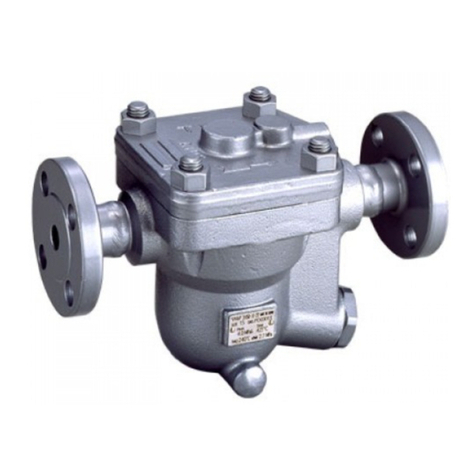
TLV
TLV JH-B series User manual

TLV
TLV UFO Series User manual

TLV
TLV PowerDyne QuickTrap P46UC-Y User manual
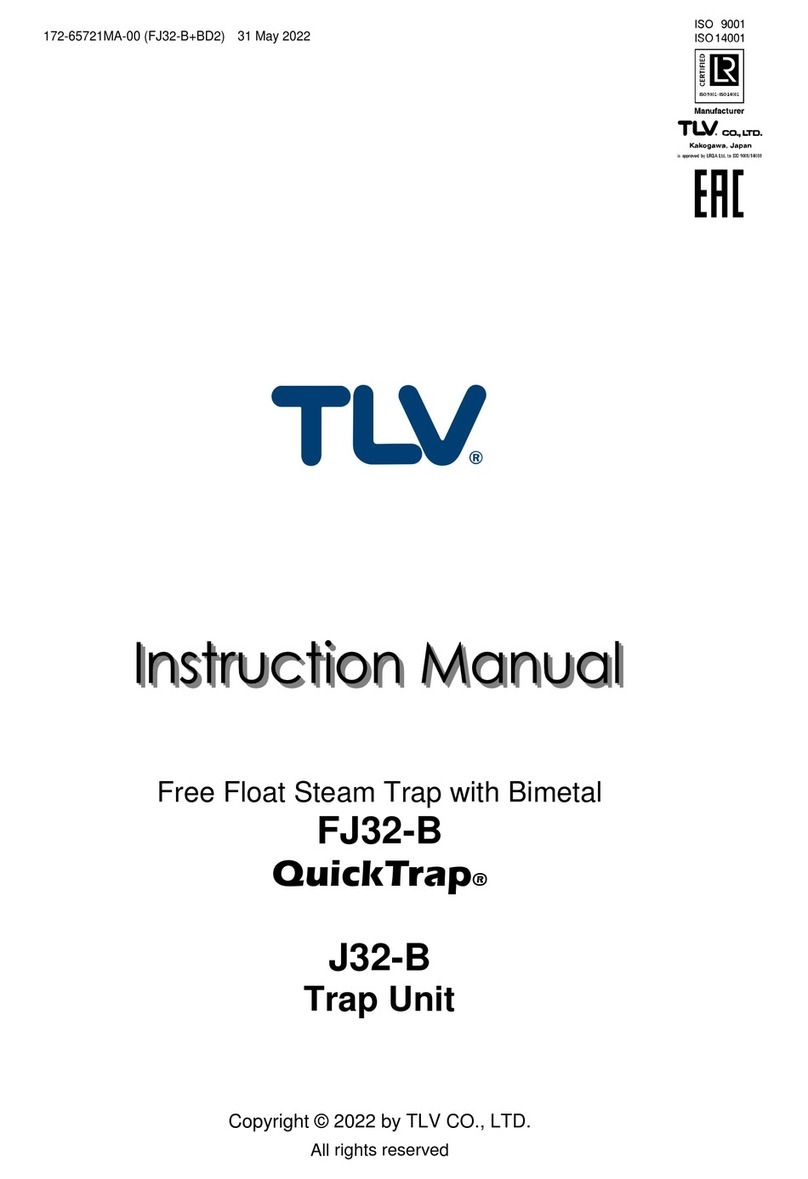
TLV
TLV QuickTrap FJ32-B User manual
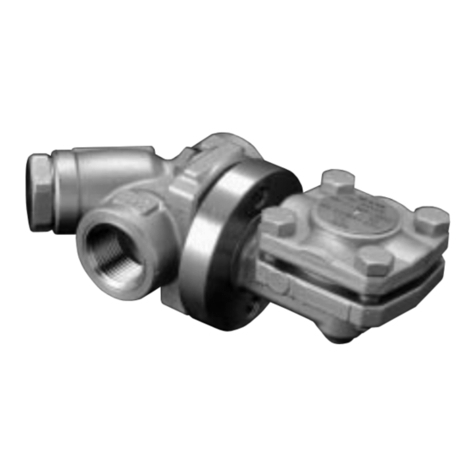
TLV
TLV QuickTrap FL Series User manual

TLV
TLV UFO3-BN User manual
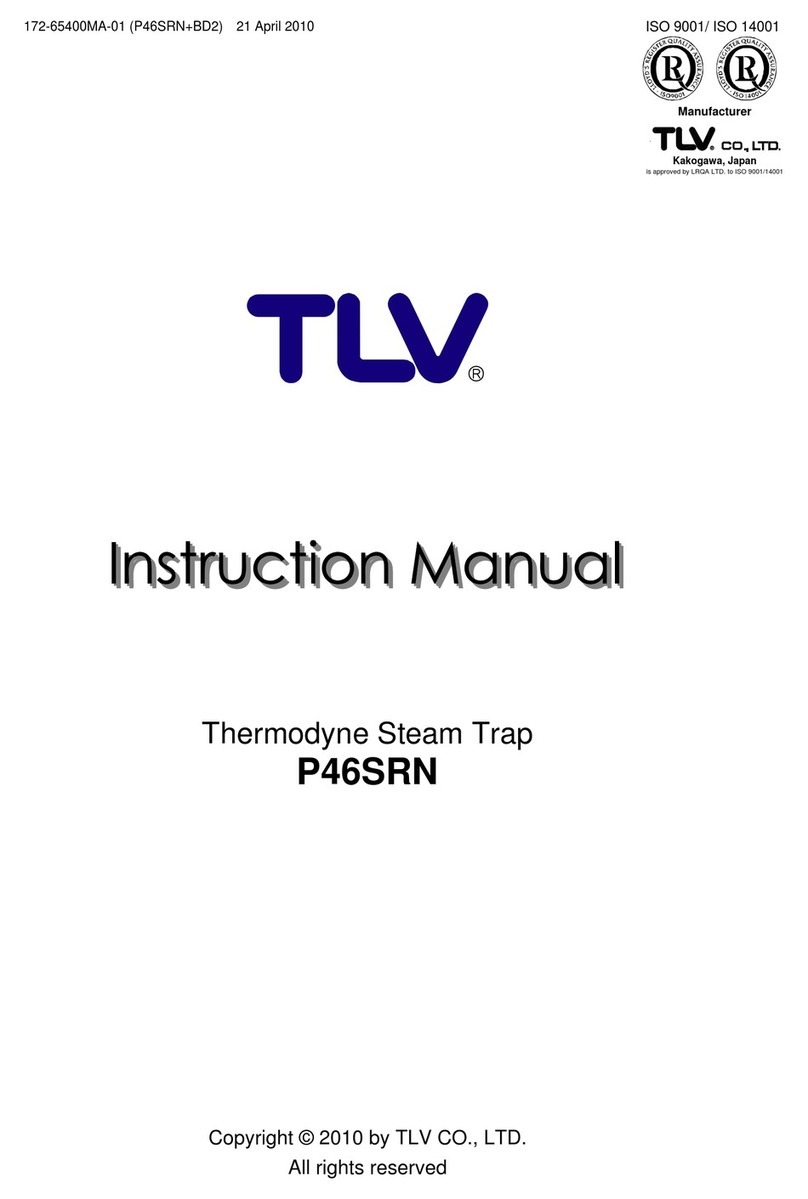
TLV
TLV PowerDyne P46SRN User manual
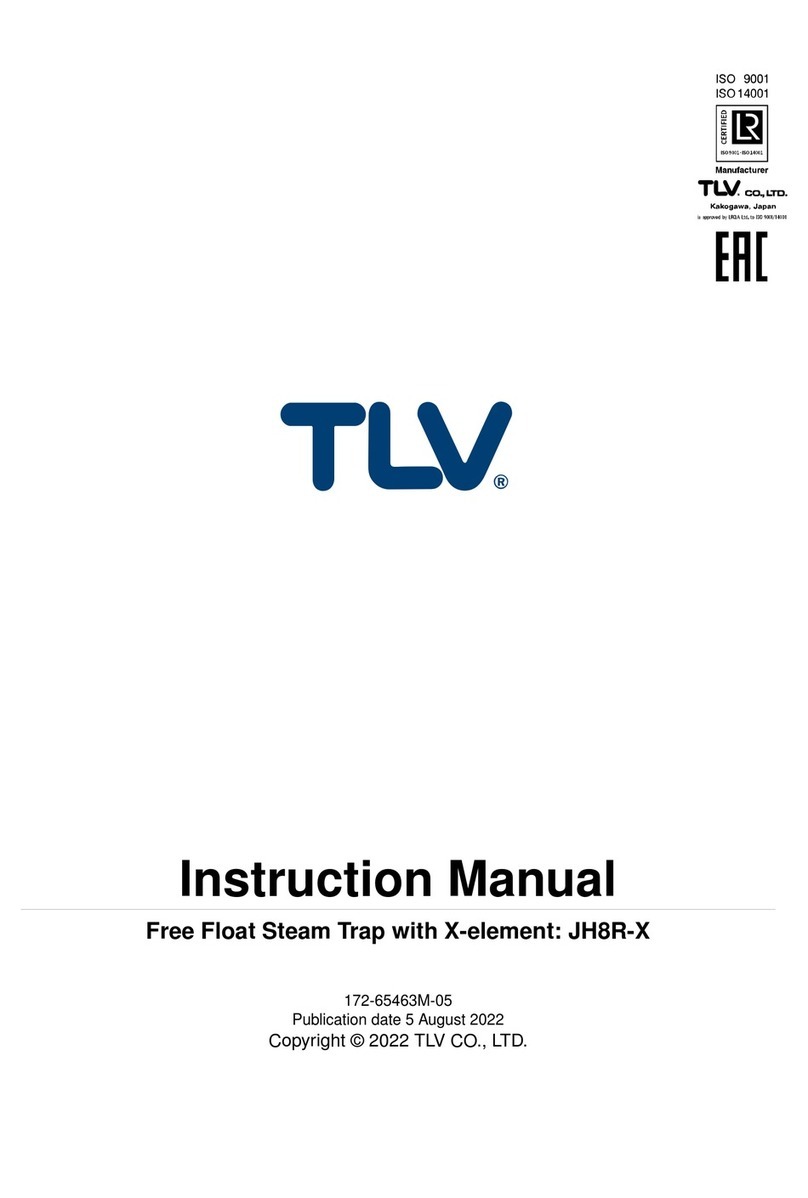
TLV
TLV JH8R-X User manual
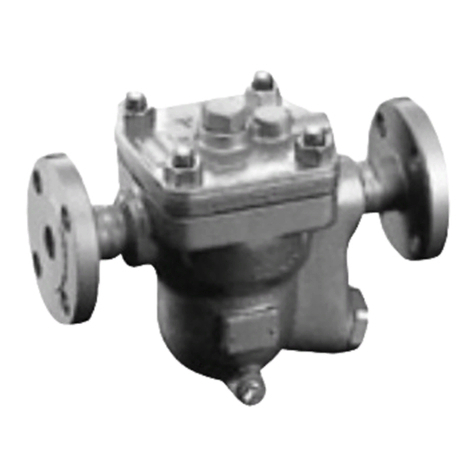
TLV
TLV JH-X Series User manual
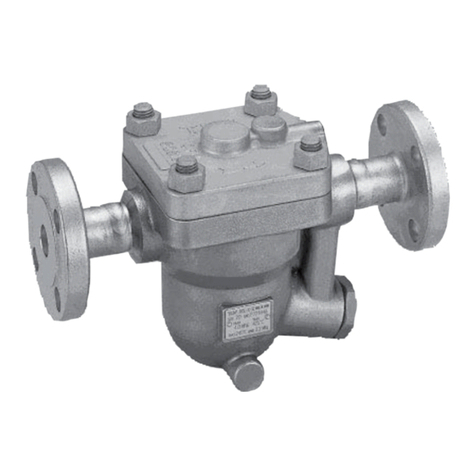
TLV
TLV JH3S-X User manual
